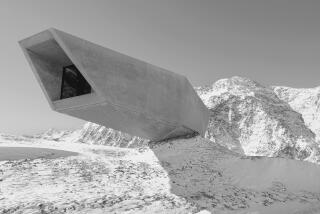There Are Many Concrete Reasons to Use It
- Share via
Most people see concrete without noticing it. To them it’s ubiquitous and, worse yet, boring. They couldn’t care less about its looks because it’s not supposed to look good.
At first, it’s hard to believe that concrete can be elegant. Worked by skilled hands, it can be finished in a variety of patterns, colors and textures, even to the point of looking like something else, including flagstone, brick and slate. This versatility expands anyone’s design options for that pool deck, patio or walkway.
Why not use brick, stone or slate? Each of these is a fine material, but natural materials (and to a lesser extent, brick) dictate the color and shape you must work with, and not all options are available in all areas.
Also, concrete generally is less expensive than quarried materials, which often must be shipped over long distances. Decorative concrete is more expensive than regular concrete, and its cost varies greatly by location and even among contractors in the same area.
Finishing concrete to make it look like brick, slate or stone is not a typical do-it-yourself project. You would have to invest in the tools and finish quite a bit of experimental concrete before you pour the main pavement.
It takes experience and the right tools to make concrete look like something it’s not, so it makes more sense to hire a masonry contractor for the job. The basic process, however, is not complicated. Masons pour and place the concrete as they would for regular concrete, using a 3,000-pound to 4,000-pound psi mix, the typical concrete for outdoor pavements.
At this point, there are several methods cement masons use to shape the concrete to look like brick, stone or slate. In one method, they press strips of building paper or a paper stencil into the wet concrete using a float.
For faux stone, the masons cut out strips of building paper. And for a brick pattern, they buy a ready-made paper stencil. Next, the masons spread colored granules over the concrete to give it the desired shade of brick or stone. They work the granules, known as dry-shake compound, into the concrete, with floats. Incidentally, dry-shake compound also increases the surface hardness of the concrete.
In the case of paper strips, the granules are carefully scraped off before the strips are lifted from the concrete. With paper lattice, the surface area is too large to do this, so the lattice is carefully peeled from the concrete after the dry-shake compound has been floated in. The area underneath the paper appears as mortar joints; the area between the strips is colored to look like slate, stone or brick. To achieve the faux finish of dry-laid stone (without contrasting-color mortar joints), the masons use stamps, rollers and mats to press a shape into the concrete.
In one example, a sheet of 2-mil polyethylene plastic is spread over the concrete. This prevents the concrete from sticking to the stamp or roller. It also gives nicely rounded edges to each stamped shape. To achieve faux mortar joints with this method, the masons spread mortar over the slab and scrape off the excess, so it fills in the joints between the stamped patterns. Afterward, they use a rotary floor polisher to remove mortar residue from the slab’s face.

